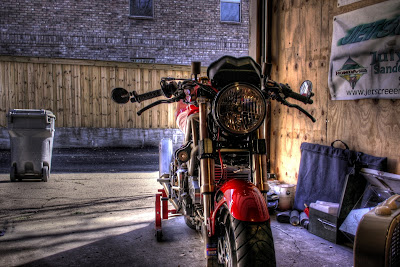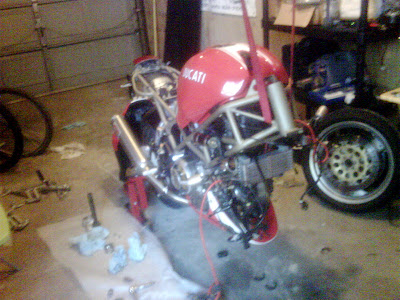Well, if you've visited here ever before, you'd notice that the name has recently changed. And has changed again.
It was originally a rebuild of a 1999 Ducati Monster 900. But the rebuild was finished years ago, and I just keep tinkering with it as the days go by. So I changed the title to "The Ducati M900", which was fitting up until about two weeks ago.
I now have a second 2v Ducati 900 motor - a project motor. It originally came in a 2002 Ducati Supersport 900ie. I came by the engine, swingarm and exhaust in not so good condition. The plan for such a motor is to get me on the track, on a fun 2v 900 that's been "built" up a bit.
Problem is, the injectors are crap. Been sitting quite awhile and they show a little bit of corrosion. Perhaps somebody is into fixing such a part up, or is in need of a set, either way - there up for grabs for cheap. Likewise, the swingarm, though it looks ok, I am not 100% sure it is straight. I do not have another Supersport swingarm to compare it to, so there's no telling at this point. (Up for grabs for cheap too.) I also acquired
three swingarm adjusters for the Supersport - anybody needing any?
Why not keep those parts? This motor is getting torn completely down, and upon rebuild completion, it is going into a non-Supersport frame. No, not another Monster. I've gotten hold of a 200
3 Ducati
748 frame that has never been registered. An american pilot that had stopped over in Italy was able to pick this up, complete with all paperwork in early 2003 since the factory had moved on to producing the 749. (2002 was the last year of the 748). So its a bit of an oddball frame - VIN shows its a 2003 748, as does the paperwork. It had never been registered because of the looming import tax waiting for it upon its registration. No big deal, mine's for track use. (How's that for stickin' it to the man?)
The plan is to make it a Monoposto 748/996/998 era superbike, without side fairings, and with a 2V 900 motor inside. Putting a 2V motor in a superbike frame is not trivial, unless - perhaps - if one was using a Hypermotard or Multistrada engine. The swingarm mounts in generally the same location, but the cases are machined narrower where it normally connects on the superbike. On the 2v motor, the swingarm bearings ride inside the engine's casing, while on the superbike, those bearings are in the swingarm. Similarly, the distance between the swingarm pivot and the rear motor mount on the 748 is slightly longer than the distance on the 2V motors. To make short work of this, I've sourced a set of 748 cases and hope to find it possible to switch everything from the 900's cases to the 748's, including cylinders and heads.
I've got a set of lightweight primaries ready for the bike, and plan to bore the cylinders to accept the Mahle 95mm pistons from Chris at CA-Cycleworks. The cylinders would be bored through Millenium Technologies, as that has been customary, with carillo rods and the crank balanced and polished (perhaps SPS style) by Fox Performance Engines. To finish off the bottom end of the motor and periphery, a lightweight flywheel and titanium bolts throughout. For ignition, a set of DynaCoils connected to another Ignitech unit, using the timing gear's two recessed teeth as the pickup (just like the pickup system on the aircooled 2v bikes). The top end will have ported heads with big lift VeeTwo "212" 'Race' cams, and MBP collets.
Fuel supply will be metered by Keihin Split Single Carburettors on short manifolds, though this will require a modification to the cross braces of the 748 frame. The tank will still be a superbike tank, though fuel will not be pumped from an internal fuel pump, but rather through the standard vacuum style pumping of the carb'd monsters, or the fuel pump of the carb'd Supersports.
Using a Superbike chassis allows me to use other Superbike parts. This includes an aluminum monoposto subframe, and an aluminum "race" fairing stay. Likewise, suspension and geometry will also be from a Superbike. This includes the triples, forks, cross-mount damper, and shock. I plan on taking my time to complete this project, so I hope to be able to carefully choose among the components that will suit my (lack) of experience best, and make for a nice, unique Ducati.
For bodywork, I plan on using a monoposto tail section, race front fairing (and air intake runners to direct air towards the carburettors and cool the vertical cylinder), superbike front and rear mudguards, and a 2V "long" belly pan. Essentially, the only fairings the bike will have is the windshield/front fairing, and the bellypan. This bike won't be naked, but perhaps you might call it "bra and panties". On the other hand, I call it:
At this point, all of my "plans" are simply ideas. The only thing I've done so far is acquire the motor, secure a frame, and then began disassembly. So far, the pile of parts removed from the motor include the flywheel, sprag gear, oil pump and gear, starter, pistons, cylinders, heads, valves, side cases and a few other small bits. The "big" pieces remain to be removed, like the primary gear(s), the timing gear and central timing belt pulleys. I'm quite open to suggestions or ideas for the build, so throw anything you have this way. If something I've said is draws a red flag, don't hesitate to let me know. I have been known to mistype things (they don't always come out they way you understand them in your head) and other times I've been wrong (happens to us all from time to time).
 2. SBK "966" Project: Less than 20% complete - 1198 forks, TPO lightweight front axle, BST wheels, working on all carbon fiber bodywork, motor needs boring plating for 95mm pistons, crank lightening/balancing, investigating ceramic hybrid bearings, looking into wiring/gauge systems (leaning towards Motogadget).
2. SBK "966" Project: Less than 20% complete - 1198 forks, TPO lightweight front axle, BST wheels, working on all carbon fiber bodywork, motor needs boring plating for 95mm pistons, crank lightening/balancing, investigating ceramic hybrid bearings, looking into wiring/gauge systems (leaning towards Motogadget). 3. "Project Monster" - The "Trackster" (not yet acquired). I have the bodywork from the "Monster Cup Challenge" or whatever it may have been called (Ducati S4 Challenge, I believe) - a Monster-only racing series that ran in England. With CA-Cycleworks' new MTT43 "Monster Track Tank". I also have lots of other Monster accessories, and I think it would be a fun, unique bike to play about on.
3. "Project Monster" - The "Trackster" (not yet acquired). I have the bodywork from the "Monster Cup Challenge" or whatever it may have been called (Ducati S4 Challenge, I believe) - a Monster-only racing series that ran in England. With CA-Cycleworks' new MTT43 "Monster Track Tank". I also have lots of other Monster accessories, and I think it would be a fun, unique bike to play about on.






